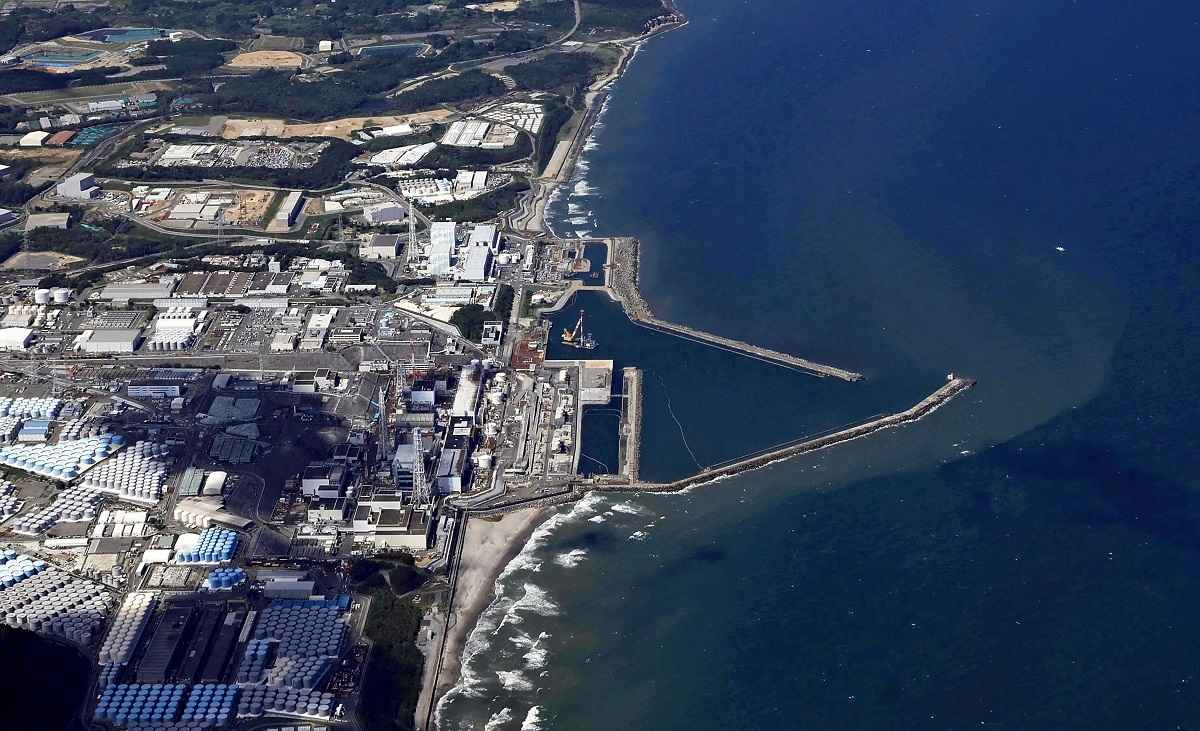Fukushima Nuclear Plant’s Diluted Treated Water Release Begins from 1 P.M. for 17-Day Discharge

The Fukushima No. 1 nuclear power plant is seen at 1:09 p.m. Thursday, minutes after the diluted treated water discharge started.
17:12 JST, August 24, 2023
For the first time since the 2011 meltdowns at the Fukushima No. 1 nuclear power plant, diluted treated water from the facility is being discharged into the ocean, Tokyo Electric Power Company Holdings, Inc. announced Thursday.
Ahead of the release, TEPCO determined that there were no problems regarding matters such as the dilution of the treated water as well as the weather and sea conditions.
The operation to release the water started at 1:03 p.m. Thursday with the activation of pumps. This first discharge will run for 17 days, with about 7,800 tons of treated water, or about 460 tons per day, being released.
Treated water is contaminated water that has been purified to remove most radioactive materials other than tritium. This contaminated water is being generated because water is used to cool the nuclear fuel that melted and solidified in the reactor cores that melted down following the 2011 Great East Japan Earthquake and tsunami.
According to TEPCO’s overall plan, the treated water will be diluted with seawater to a concentration of 1,500 becquerels of tritium per liter before discharge, whereas the national standard allows up to 60,000 becquerels. Using extreme caution, TEPCO is diluting the treated water for this first discharge so that the tritium concentration will be about 190 becquerels per liter.
The diluted water is being discharged through an undersea tunnel that leads to an opening about 1 kilometer offshore from the plant.
TEPCO said that through the fiscal year ending March 2024, it plans to release about 31,200 tons of treated water, or about 2% of total amount of such water stored at the facility. The current discharge is the first of four such operations this fiscal year.
The treated water discharge will continue over a period of about 30 years, an important step toward the decommissioning of the crippled power plant, which the government and TEPCO aim to complete in 2041-51.
Since Tuesday, TEPCO has checked the dilution process, diluting about 1 ton of treated water with about 1,200 tons of seawater. According to TEPCO, the tritium concentration had dropped, with a maximum of 63 becquerels per liter measured.
The Japan Atomic Energy Agency also conducted its own third-party test and found the tritium concentration was in line with the results of TEPCO’s test.
“We are handling matters with a heightened sense of urgency,” said Junichi Matsumoto, a TEPCO corporate officer in charge of treated water discharge operations, during a press conference held at the Fukushima No.1 nuclear power plant on Thursday.
From Friday, government and TEPCO websites will announce the results from the radiation monitoring of the sea around the plant.
"Society" POPULAR ARTICLE
-

M4.9 Earthquake Hits Tokyo, Neighboring Prefectures
-

M7.5 Earthquake Hits Northern Japan; Tsunami Waves Observed in Hokkaido, Aomori and Iwate Prefectures
-

Tsukiji Market Urges Tourists to Avoid Visiting in Year-End
-

Israeli Tourists Refused Accommodation at Hotel in Japan’s Nagano Pref., Prompting Protest by Israeli Embassy and Probe by Prefecture
-

M5.7 Earthquake Hits Japan’s Kumamoto Pref., Measuring Upper 5 Intensity, No Tsunami Expected
JN ACCESS RANKING
-

Keidanren Chairman Yoshinobu Tsutsui Visits Kashiwazaki-Kariwa Nuclear Power Plant; Inspects New Emergency Safety System
-

Imports of Rare Earths from China Facing Delays, May Be Caused by Deterioration of Japan-China Relations
-

University of Tokyo Professor Discusses Japanese Economic Security in Interview Ahead of Forum
-

Japan Pulls out of Vietnam Nuclear Project, Complicating Hanoi’s Power Plans
-

Govt Aims to Expand NISA Program Lineup, Abolish Age Restriction






















